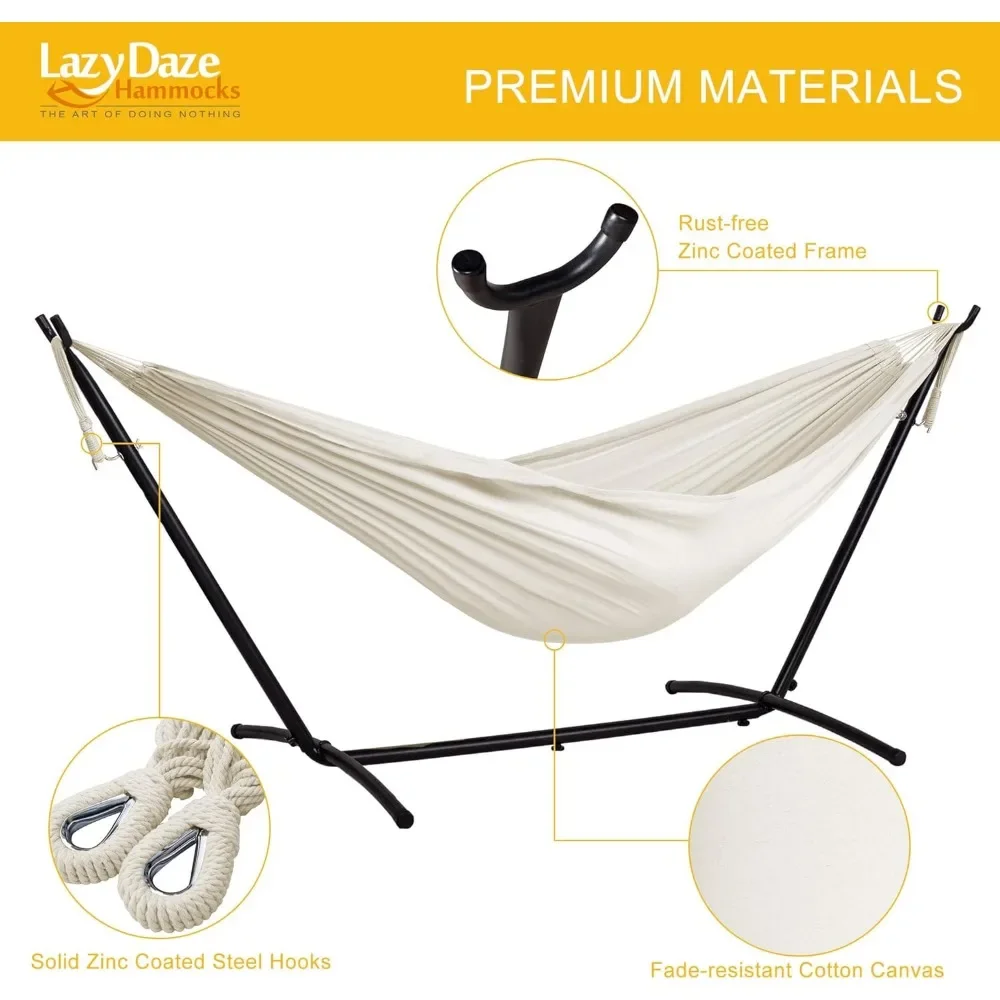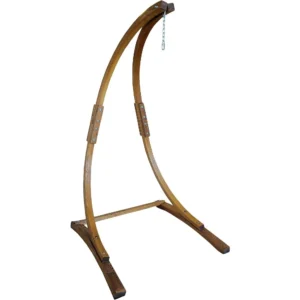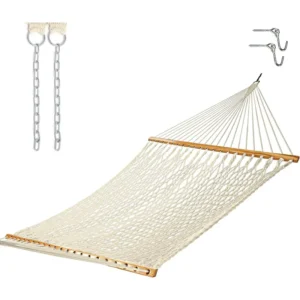Introduction: Understanding the Challenge of an Unstable Hammock Stand
Picture this: you’ve just set up your beautiful double hammock stand in the backyard, eager to enjoy a peaceful afternoon with your partner or friend. You both climb in, ready to relax, when suddenly—wobble, wobble, tip! What should have been a moment of pure bliss turns into an unsettling experience of trying to balance and stay upright.
This scenario is all too common for double hammock owners. Stability isn’t just about comfort—it’s fundamentally about safety, relaxation quality, and ensuring your hammock equipment lasts for years to come. Double hammock stands are particularly susceptible to stability issues due to their wider design and greater weight capacity requirements (typically 450-600 pounds).
The good news is that most stability issues can be fixed with the right approach. This guide will walk you through:
- Quick fixes you can implement right away
- Surface-specific solutions for grass, concrete, decks, and indoor use
- Long-term stabilization strategies for persistent problems
- Proper usage techniques to prevent instability in the first place
Understanding the design principles of two person hammocks stands is essential to properly addressing stability issues. With proper stabilization, your double hammock can become the safe haven of relaxation you’ve always wanted it to be.
Each year, hundreds of hammock-related incidents occur due to unstable setups. But don’t worry—by the end of this article, you’ll have all the knowledge needed to transform your wobbly hammock stand into a rock-solid relaxation station. The benefits of stable double hammocks make these efforts well worth your time.
Common Causes of Double Hammock Stand Instability
Before jumping into solutions, it’s important to understand what causes your hammock stand to wobble in the first place. Identifying the root of the problem will help you apply the most effective fix.
Surface Issues
- Uneven ground: Even slight slopes or dips can create major instability
- Soft surfaces: Stands sink into soft soil, sand, or wet grass, creating an imbalance
- Slippery surfaces: Hard, smooth surfaces like tile or polished concrete allow the feet to slide
Assembly Problems
- Loose connections: Bolts and nuts that have vibrated loose over time
- Incorrect alignment: Components not properly aligned during assembly
- Missing parts: Missing washers or stabilizing components that were overlooked
Material and Design Limitations
- Lightweight materials: Some budget stands use thinner metals that flex under weight
- Narrow base design: Stands with a smaller footprint are inherently less stable
- High center of gravity: Taller stands without compensating base width tend to tip more easily
Usage Factors
- Improper weight distribution: Uneven weight between users or sitting on the edge
- Exceeding capacity: Putting too much weight on the stand
- Dynamic movements: Swinging, bouncing, or getting in and out improperly
When two adults share a hammock, their combined weight can create stress points on the frame, especially if the stand wasn’t properly designed for double use. Understanding your hammock’s weight limits is crucial for maintaining stability and safety.
Environmental factors like wind exposure and shifting ground conditions can also contribute to instability. A stand that’s perfectly stable on day one might develop wobbles after rain softens the ground or repeated use shifts its position.
Assessing Your Stand: How to Diagnose the Specific Problem
Before applying fixes, take a methodical approach to identifying exactly what’s causing your stand to wobble. This targeted assessment will save you time and effort in the long run.
Visual Inspection Checklist:
- Check all connecting points for visible gaps
- Look for bent, warped, or damaged frame components
- Verify that all parts are present according to the assembly manual
- Examine the feet for wear, damage, or uneven contact with the ground
- Check if the hammock is hanging evenly and at the recommended angle
Testing Procedure:
- Gently rock an empty stand to identify where movement originates
- Tighten all visible hardware connections with appropriate tools
- Check levelness using a bubble level or smartphone level app
- Test each foot for firm, even contact with the ground
- Observe the stand while in use (have someone watch while you carefully sit in it)
Warning Signs of Serious Issues:
- Cracked welds or connections
- Significant corrosion or rust at stress points
- Metal fatigue signs like discoloration or fine cracks
- Excessive flexing of main support bars when weight is applied
If you notice severe structural issues, it might be time to consider heavy-duty hammock sets designed specifically to provide enhanced stability and support. However, most stability problems can be addressed with simpler solutions.
Take notes about what you observe during this assessment phase. Does the stand tip forward or backward? Does it wobble side-to-side? Does it sink into the ground? Your observations will guide which solutions will work best.
Quick Fixes for Immediate Stability Improvement
Now that you’ve identified the specific issues, here are some quick fixes you can implement right away for immediate improvement:
1. Tighten All Hardware
Using appropriate wrenches or tools:
1. Systematically check every bolt, nut, and connector
2. Tighten in a pattern (like tightening lug nuts on a car) rather than one side at a time
3. Don’t over-tighten, which can strip threads or deform components
4. Apply thread locker (blue, not red) to connections that repeatedly come loose
2. Level Your Stand
- Place small, flat pieces of wood or plastic shims under legs that don’t contact the ground fully
- Use adjustable feet if your stand has them
- Consider installing aftermarket adjustable feet for permanent leveling capability
- Create a level base with patio pavers or deck blocks
3. Correct Hammock Hanging Technique
- Ensure your hammock hangs with a 30-degree angle from horizontal
- Verify equal tension on both attachment points
- Adjust height so the hammock sits at proper height when weighted
- Check that attachment hooks or carabiners are fully closed and secure
4. Reposition Your Stand
- Rotate the stand 90 degrees if the instability is directional
- Move to firmer ground or a flatter surface
- Position longer sides of the base perpendicular to the direction you enter the hammock
- Place away from slopes or transitions between different ground types
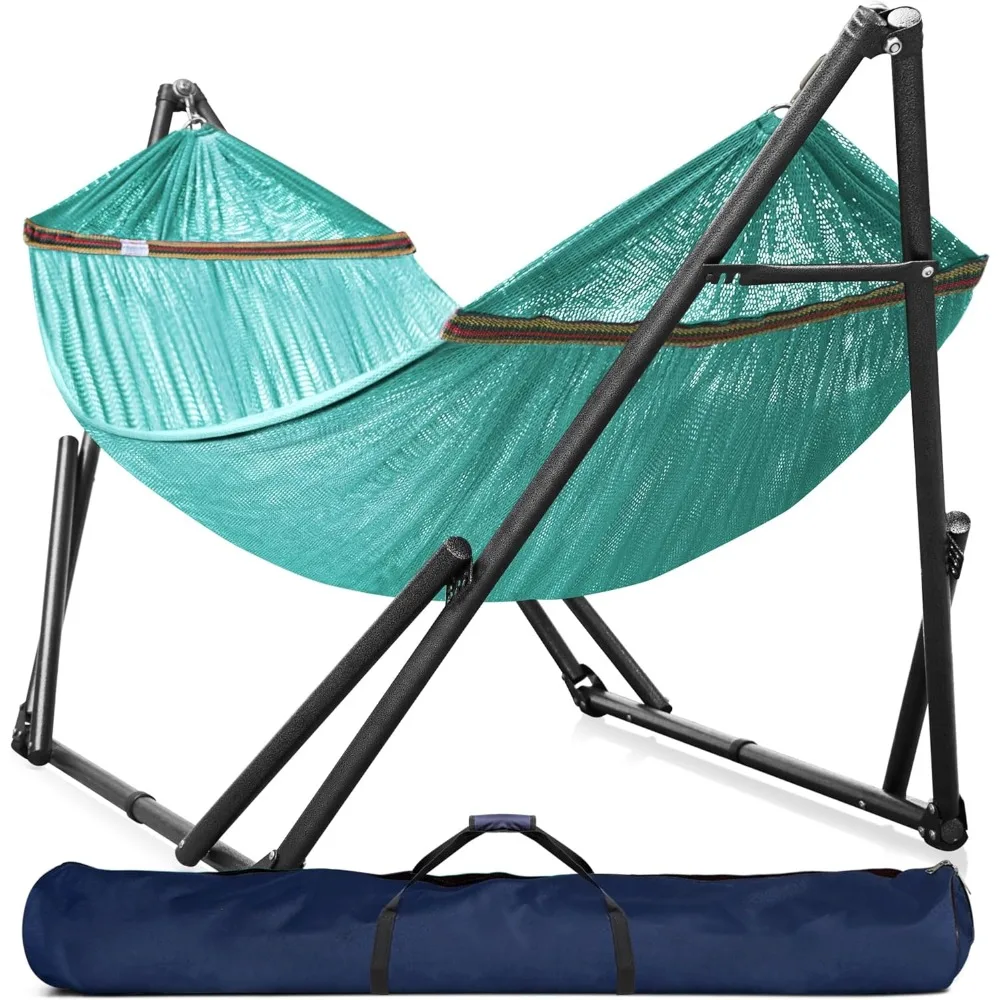
5. Temporary Stabilizers
- Place non-slip furniture pads under each foot
- Add weight to the base using sandbags or gallon water jugs
- Create temporary cross-bracing with rope or straps
- Use rubber exercise mats under the entire stand to prevent sliding
Many users find success with these simple adjustments and don’t need more extensive solutions. If you’re in the market for a new setup, consider exploring double two-person hammock sets specifically designed to minimize wobbling issues through improved engineering.
Surface-Specific Stabilization Techniques
Different surfaces require different stabilization approaches. Let’s explore solutions tailored to where you’re placing your hammock stand.
A. Grass and Soft Ground Solutions
Soft surfaces create unique challenges as stands can sink and shift over time:
Ground Stakes and Anchors:
1. Purchase spiral dog stakes or 12-inch tent stakes
2. Drive stakes at a 45-degree angle away from the stand
3. Connect stakes to the stand base with strong rope or ratchet straps
4. Place one anchor at each corner of the stand base
Solid Base Creation:
1. Lay down landscaping fabric to prevent weed growth
2. Create a level pad using pea gravel or sand
3. Place concrete pavers or composite decking boards on top
4. Position your hammock stand on this newly created stable surface
DIY Ground Anchor System:
1. Bury horizontal “deadman” anchors (pressure-treated 2×4s) perpendicular to the hammock direction
2. Attach eye bolts to the buried wood
3. Connect stand to eye bolts using turnbuckles for adjustable tension
4. Cover system with a thin layer of soil or mulch for aesthetics
B. Hard Surface Solutions
Hard surfaces like concrete, tile, and wood decking present different challenges:
Non-Slip Attachments:
1. Apply rubber furniture pads or rubber chair leg caps to stand feet
2. Cut sections of rubber shelf liner to place under each foot
3. Use silicone caulk to create custom-molded foot pads (let dry completely before use)
4. Install commercial non-slip rubber feet designed for furniture or equipment
Weight-Based Stabilization:
1. Place sandbags or concrete blocks on the base bars (at least 20-40 pounds per side)
2. Use decorative planters filled with soil or concrete as weights
3. Purchase purpose-made hammock weight bags that straddle the base
4. Create a counterweight system using gallon water jugs in attractive containers
Temporary Anchoring Without Damage:
1. Use tension-based solutions that press against walls or railings
2. Apply non-marking rubber-coated clamps to deck edges
3. Create friction-based stabilizers using rubber mats under the entire stand
4. For wooden decks, use temporary deck fasteners that clamp rather than screw
C. Indoor Stabilization Methods
Indoor use requires special attention to both stability and floor protection:
Floor-Friendly Techniques:
1. Place area rugs or exercise mats under the entire stand
2. Use furniture sliders in reverse (rubber side down) under each foot
3. Apply felt pads topped with non-slip rubber discs to each contact point
4. Create a custom platform base from plywood covered with carpet
Creating Wider Base Support:
1. Attach wooden extensions to the base bars using U-bolts
2. Add stabilizing crossbars between the legs using plumbing pipes and connectors
3. Create an interlocking platform that the original stand sits within
4. Use furniture straps to connect to heavy nearby furniture for additional support
When setting up your double hammock, be sure to follow space guide recommendations to ensure your stabilization efforts aren’t compromised by improper positioning.
Advanced Stabilization Methods for Persistent Problems
If you’ve tried the quick fixes and surface-specific solutions but still experience wobbling, it’s time for more robust approaches.
Adding Weight to the Base
Strategic Weight Placement:
– Add weights directly above the feet for maximum stabilizing effect
– Distribute weight evenly to prevent new imbalances
– Secure weights so they can’t shift during use
– Consider how added weight affects portability
Effective Weight Options:
1. Purpose-made hammock weight bags (easiest but most expensive)
2. Sandbags wrapped in weather-resistant material (20-40 pounds per corner)
3. Concrete blocks decorated or covered for aesthetic appeal
4. Water weight bags that can be emptied for storage
Expanding the Footprint
DIY Base Widening:
1. Create T-extensions from pressure-treated lumber to extend the base width
2. Attach metal angle brackets to the existing feet, extending outward 12-18 inches
3. Build a separate wooden platform with recesses where the stand feet lock in
4. Add horizontal stabilizer bars to create a wider rectangular base
Pros:
– Dramatically improves side-to-side stability
– Creates a more proportional base-to-height ratio
– Can be made to look intentional and attractive
Cons:
– Increases the stand’s footprint significantly
– May make the stand less portable
– Requires moderate DIY skills
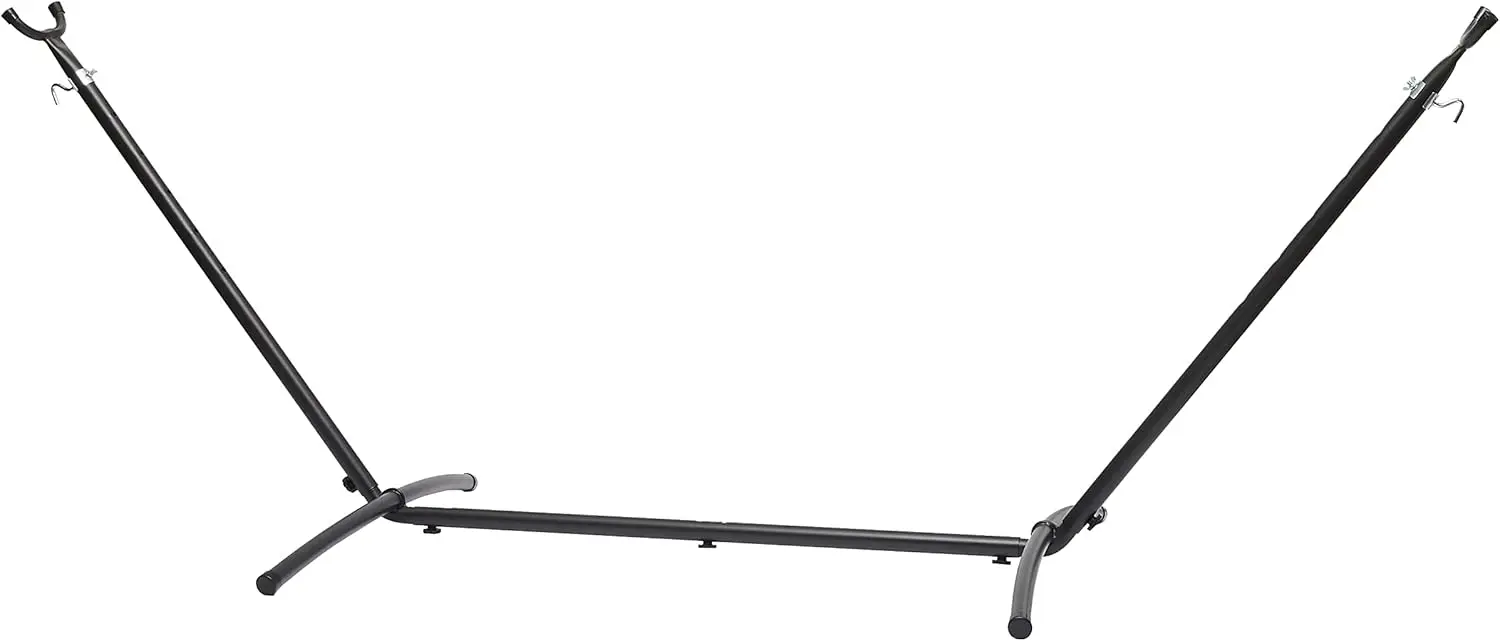
Crossbar Additions
Adding Structural Support:
1. Install diagonal bracing between vertical and horizontal components
2. Add secondary crossbars parallel to existing ones for reinforcement
3. Create triangulation supports at key stress points
4. Retrofit with steel cable cross-bracing with turnbuckles for tension adjustment
For those seeking maximum stability without DIY efforts, A-frame stand hammock sets often provide superior stability due to their triangular structural design.
Anti-Tip Straps and Commercial Solutions
Professional Stabilizing Products:
1. Hammock stand stability kits with ground anchors and straps
2. Anti-tip straps that extend the functional base width
3. Weight bags specifically designed to mount on hammock stands
4. Aftermarket wider feet replacements for common stand models
Implementation:
– Follow manufacturer instructions precisely
– Combine commercial solutions with DIY enhancements for best results
– Choose weather-resistant materials for outdoor applications
– Test gradually with increasing weight to ensure effectiveness
The cost of these advanced solutions typically ranges from $30-100, still significantly less than replacing a quality hammock stand entirely.
Dark Wood Hammock Sets, Porch Swing Chair Sets
$653.82 Select options This product has multiple variants. The options may be chosen on the product pageA-Frame Stand Hammock Sets, Swinging Hammock Chair Sets
$154.62 Select options This product has multiple variants. The options may be chosen on the product pageLight Wood Hammock Sets, Swinging Hammock Chair Sets
$1,359.35 Select options This product has multiple variants. The options may be chosen on the product pageClassic Wooden Stand Hammock Sets, Heavy Duty Hammock Sets
$1,061.68 Select options This product has multiple variants. The options may be chosen on the product pageHammock Sets with Canopy, Heavy Duty Hammock Sets
$286.31 Select options This product has multiple variants. The options may be chosen on the product pageDouble / Two Person Hammock Sets, Rope Hammock Sets
Double Traditional Cotton Rope Hammock with Extension Chains – 450 lbs Capacity for Backyard & Patio$292.98 Select options This product has multiple variants. The options may be chosen on the product page
Proper Usage Techniques to Prevent Instability
Even the most stable hammock stand can wobble if used improperly. These techniques will help maintain stability during use:
Correct Entry and Exit
- Approach the hammock from the side, not the end
- Place your hand on the stand for support while sitting
- Sit in the middle of the hammock first, then swing legs in
- Distribute your weight gradually as you lie back
- For exiting, reverse the process—sit up first, then place feet on the ground
Weight Distribution Best Practices
- Center yourself in the hammock (or position two people evenly)
- Avoid sitting on the very edge of the hammock
- For two people, enter one at a time, allowing adjustment between entries
- Position heavier person in the center if weight difference is significant
Movements to Avoid
- Sudden bouncing or rocking
- Standing up in the hammock
- Getting in or out by pulling on the end bars of the stand
- Exceeding the recommended weight capacity
- Swinging side to side aggressively
Learning about durable hammock stand relaxation techniques can help you enjoy your hammock without compromising its stability or safety.
Maintenance for Long-Term Stability
Regular maintenance prevents small issues from becoming major stability problems:
Monthly Inspection Checklist:
- Check and tighten all bolts, nuts, and connections
- Inspect for developing rust or corrosion at joints
- Look for signs of metal fatigue or stress
- Verify that feet remain level and in good condition
- Examine hammock attachment points for wear
Seasonal Maintenance:
- Apply rust inhibitor to metal parts before rainy seasons
- Check wooden components for weathering or splitting
- Verify ground conditions haven’t changed under the stand
- Adjust stabilizers as needed for seasonal ground changes
- Apply lubricant to moving parts and connections
Proper Storage Practices:
- Store indoors during extreme weather if possible
- Cover with a waterproof cover if left outdoors
- Remove fabric hammock components for separate storage
- Store stabilizing weights in a dry area to prevent deterioration
- Keep hardware in labeled bags if disassembling for storage
For stands made of natural materials, wooden hammocks stands require specific maintenance approaches to maintain their stability and appearance over time.
When to Consider a New Stand: Signs It’s Time for an Upgrade
Despite best efforts, sometimes replacement is the wisest choice. Watch for these warning signs:
Red Flags for Replacement:
- Cracked or broken main structural components
- Significant rust that has compromised metal integrity
- Repeated instability despite multiple stabilization attempts
- Visible bending or deformation of support bars
- Consistent wobbling that causes anxiety during use
Cost-Benefit Considerations:
- When stabilization materials approach 50% of a new stand’s cost
- If modifications make the stand cumbersome or unattractive
- When the time invested in repeated fixes becomes excessive
- If safety concerns persist despite interventions
Key Upgrade Features Worth Investing In:
- Wider base design with lower center of gravity
- Heavier gauge metal construction
- Built-in stabilization features
- Higher weight capacity rating
- Anti-tip design elements
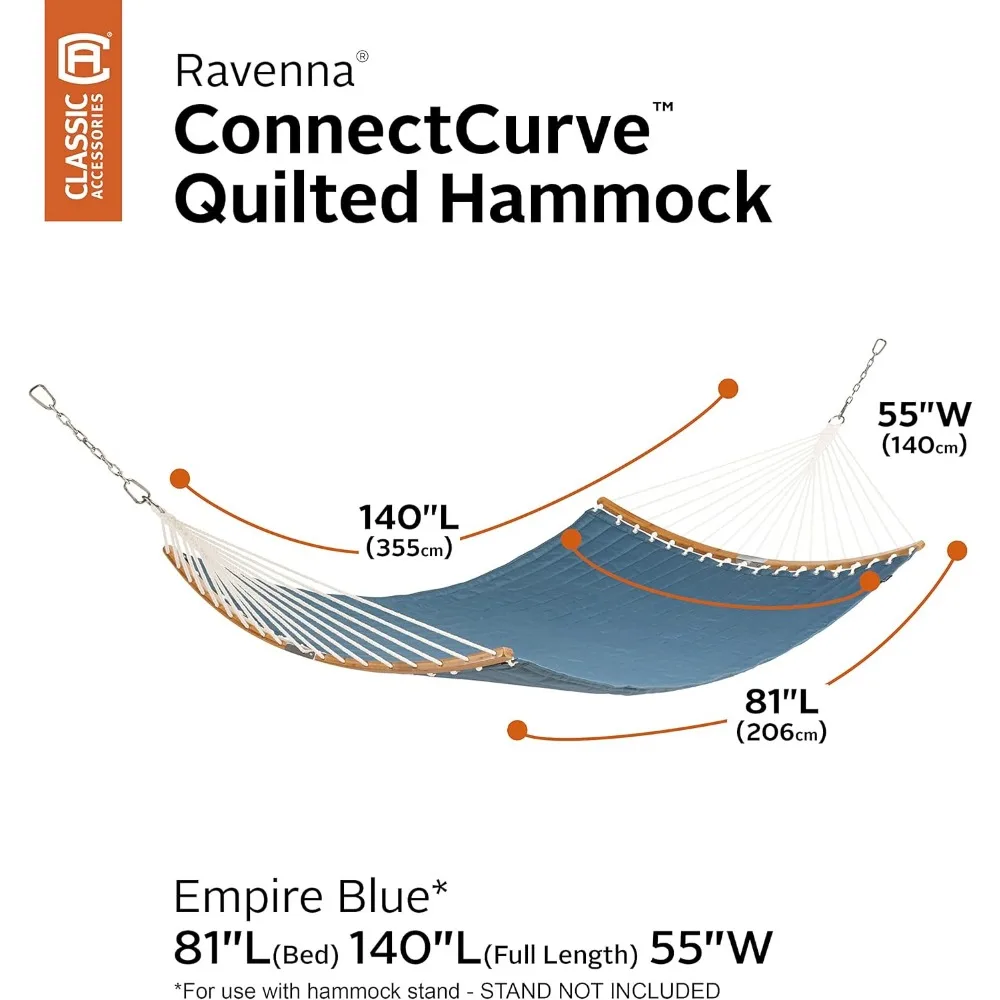
Understanding the differences between steel vs wood hammock stands can help you make an informed replacement decision based on stability needs.
Choosing the Right Stand: Stability Features to Look For
If you decide to upgrade, prioritize these features for maximum stability:
Base Design Priority:
- Look for base width at least 40-50% of the stand height
- Choose stands with feet that extend beyond the vertical supports
- Select designs with lower center of gravity
- Prioritize models with wider stance at the ends where force is applied
Material Considerations:
- Heavier gauge steel (12-14 gauge) offers better stability than lighter options
- Powder-coated steel provides durability without excessive weight
- Hardwoods like oak or cypress offer natural weight and stability
- Avoid lightweight aluminum for double hammock applications
The right materials make a tremendous difference in hammock stand stability. Learning about the strongest materials for hammock stands will help you make an informed choice for your specific needs.
Anti-Tip Features:
- Built-in anchor points for ground stakes
- Pre-installed wider feet or stabilizer bars
- Lower hanging point design that reduces tipping leverage
- Weight bags or compartments designed specifically for the stand
Conclusion: Enjoying Your Double Hammock with Complete Confidence
With the right approach to stabilization, your double hammock stand can transform from a wobbly worry into a rock-solid relaxation haven. We’ve covered everything from quick fixes to advanced solutions, helping you identify and address the specific causes of your stand’s instability.
Remember that stability comes from a combination of:
– Proper assembly and maintenance
– Surface-appropriate stabilization techniques
– Correct usage and weight distribution
– Strategic modifications when needed
By implementing the techniques that address your specific situation, you’ll create a safe, comfortable hammock experience that lets you truly relax. The peace of mind that comes from a properly stabilized hammock stand is invaluable—no more worrying about tipping or wobbling when you should be enjoying your leisure time.
For couples especially, creating a stable platform enhances the entire experience. The features of freestanding hammocks for couples extend beyond just stability to overall comfort and durability.
Take action today with the simplest solutions first, then progress to more advanced techniques if needed. Your perfect, wobble-free hammock experience awaits!

